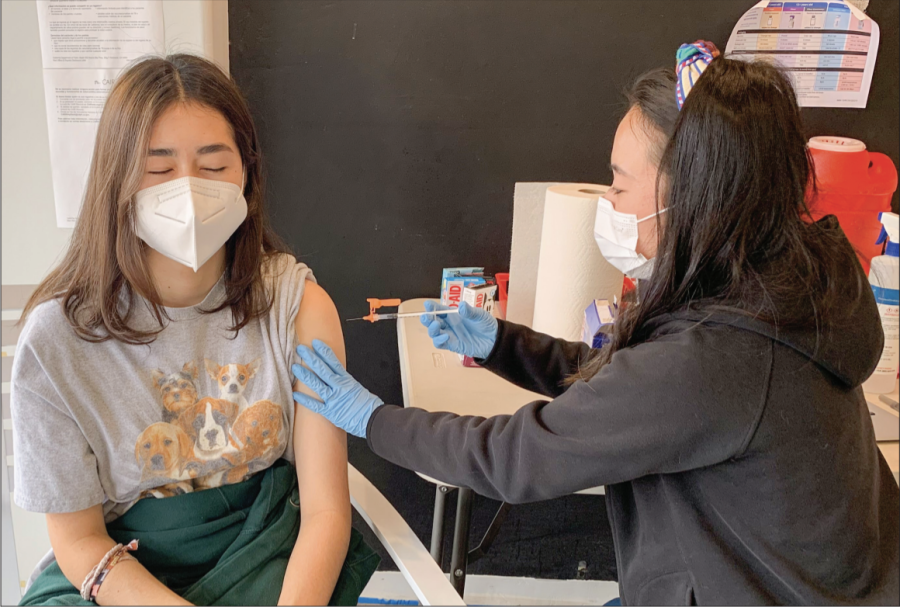Administration issues new COVID-19 protocols amid surge in cases
Head Prefect and Executive Editor Quincey Dern ’22 takes a deep breath before receiving the COVID-19 booster shot at Elements Pharmacy.
January 19, 2022
The administration updated COVID-19 testing and protocols in an effort to both maintain in-person learning and accommodate those self-quarantining in response to the increased positive COVID-19 infection rate among the school community.
Head of Upper School Beth Slattery informed all upper school families of the return to school plans in an email sent Dec. 31. Those who tested positive on the designated testing day were required to self-isolate for a minimum of five days and show proof of a negative test upon their return to school.
Moreover, instead of pooled rapid testing, as the school has done for the majority of the year, students now take individual rapid PCR tests once per week. Additionally, students attending school in person were asked to take notes for their peers at home, and teachers offered live Zoom meetings and recordings as resources for those learning remotely.
Zoe Shapiro ’23 said she agrees with the school’s decision to switch its manner of testing given the high rate of infection among the members of the community.
“Even though my family and I discussed how this strain spreads much faster, I still found it shocking that so many people caught [COVID-19],” Shapiro said. “I think the individual PCR tests are crucial to slowing the spread of COVID-19 since a lot of students had it over [winter] break and a lot have it now.”
In another email sent Jan. 6, Slattery outlined new mask-wearing protocols as well as consequences students will face if they do not abide by them. Students are required to wear N95, KF94 or KN95 masks both outside, if social distancing is not possible, and inside. If students fail to comply, they could be sent home and face an Honor Board case.
Owen Kim ’23 said although he understands the reasoning behind the updated mask-wearing guidelines, he prove inconvenient at times.
“I feel like wearing the KN95 [masks] both inside and outside is appropriate, but [the masks] are very uncomfortable,” Kim said. “They irritate my ears and neck, and sometimes, they affect my concentration during assessments. Having to wear them outside during lunchtime seems impractical as well, given the amount of space lunch tables have.”
Kim said he feels ambivalent about the consequences students could potentially face for failing to adhere to the school’s new COVID-19 policies.
“I think being sent home is reasonable because it helps ensure continued in-person learning, but I feel being Honor Boarded is reserved for more serious offenses, like plagiarism,” Kim said. “At the same time, though, I have a hard time coming up with another punishment that would really force students to follow these guidelines.”
Slattery said she plans to reserve student punishments for breaking COVID-19 protocol only in exceptional cases.
“I hope I don’t have to send anyone home, but if I do, they would be allowed to return the next day,” Slattery said. “I recognize that most failure to mask is unintentional and I only intend to invoke the Honor Board or other penalties for repeat offenders or those who appear to intentionally flaunt the rules.”
Science Teacher Jesus Salas said he supports the school’s updated masking policies.
“N95, KN95 and KF94 masks offer better protection than regular surgical or cloth masks,” Salas said. “Therefore, requiring everyone on campus to wear one such mask inside and outside is most certainly a good decision, as this reduces the transmission of COVID-19 on campus.”
History Teacher Sandra Brasda said she prefers the direct teaching experience to the remote one.
“Nothing replaces the student-to-teacher in-person connection that a physical classroom provides,” Brasda said. “In-person teaching creates stronger relationships and a deeper learning environment, while teaching online is like teaching a whole new course that you have not taught before. You simply cannot teach the material the same way online as you would in class. They each require different tactics and pedagogical methods.”
Brasda said a combination of in-person and online learning does not necessarily guarantee an easier experience for students and teachers.
“Hybrid learning is also very difficult because it requires that the teacher’s time, attention and energy be divided between the students physically in the class and those online,” Brasda said. “In addition, there also needs to be buy-in from both the teacher and student. [With a hybrid model,] students need to make a concerted effort to engage in an online platform and teachers need to adapt to different learning styles.”
President Rick Commons said the school values the in-person learning experience and that the administration will do their utmost to mitigate the spread of COVID-19.
“There has been a very strong majority voice in our community that being in person really matters,” Commons said. “[Although] you can convey a lot of information on Zoom, you cannot create the community and the culture that matters so much to us, but our main concern in coming back to school in person was how to do so as safely as possible.”
Slattery said the school will prioritize the community’s health in determining its COVID-19 policy.
“The school is committed to staying in person, but I cannot promise that circumstances will always allow for that,” Slattery said. “The only promise I can make is that we will make the best decisions we can, following guidelines and taking into account the mental and physical health of all the people in our care.”































